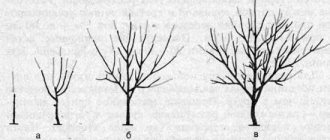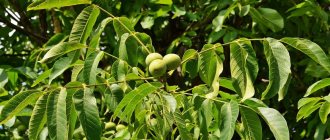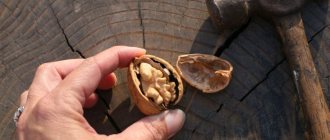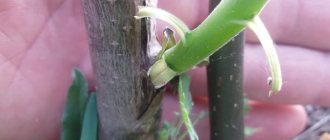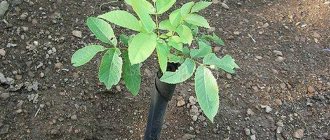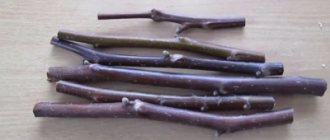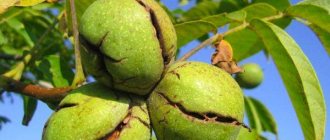Choice of location, soil
The plant's young shoots, leaves and flowers are very sensitive to spring frosts, so the plant cannot be grown everywhere. The tree grows better in warm regions of the country.
Unfortunately, severe frosts are destructive for nuts; at a temperature of -27-28 °C the tree freezes.
You can grow walnuts in the Moscow region, in the middle zone, in areas protected from the wind, but the risk of freezing is high. In the Leningrad region, the tree does not freeze completely, but grows depressed and often freezes. The tree grows best in warm regions of Russia - south of Voronezh, partly in Belarus and Ukraine. Growing walnuts in Siberia and the Urals is not practical.
For planting, choose a warm, sunny, wind-protected place. The plant needs sun; western, southwestern and northwestern exposures are most favorable.
This nut forms an extensive, well-developed root and does not like to be transplanted, so before planting trees, you must immediately choose a suitable place. The plant prefers a sunny position. It is worth finding a secluded place, protected from wind and frost.
The tree is quite tall and spreading. It is necessary to provide it with plenty of space due to its strong growth and wide crown. In small areas, only grafted trees that do not form extensive crowns can be grown.
The soil should be:
- loamy,
- permeable,
- rich in humus and nutrients,
- moderately humid,
- containing a lot of calcium and having a neutral or alkaline pH.
The nut does not tolerate heavy, wet, cold, poor soils, where it grows poorly and often gets sick.
Before planting, the soil is dug up, loosened, enriched with nutrients, and weeds are removed. Nuts do not tolerate even slightly acidic soil. When the pH is below 6.5, liming is necessary.
Pests and diseases
Compared to many other cultivated trees, walnut is less susceptible to diseases and pests. Typically, problems begin in the case of insufficient lighting, low soil nutrition, excess moisture and recurrent frosts in the spring season. The most common diseases that can affect walnuts are:
- Bacteriosis is a plant disease that most often develops in nuts in the spring. The main provocateur is high humidity combined with elevated ambient temperature. Dark spots appear on the trunk and stems, the wood turns brown, and young shoots die. To eliminate, use 3% Bordeaux mixture or 1% urea solution.
- Root cancer is a tumor disease of the root system of trees. Typically, this pathology develops in case of damage to the surface of the roots. When lumpy growths appear on the roots, the development of the plant is suspended. If root cancer is detected, you need to cut off all damaged parts and treat the bare areas with a 1% caustic soda solution.
- Brown spot is a fungal infection of vegetation that develops against the background of severe waterlogging of the soil, from watering or prolonged rains. During development during the flowering period, most of the buds fall off. The appearance of red-brown and gray-brown spots on the leaves and stems is typical. To eliminate, use 1% Bordeaux mixture. It is recommended to process at least 3 times with a break of 7 days.
Any pests that can attack the nut lead to a slowdown in the overall development of the tree and a reduction in fruiting. To prevent the development of such a problem, it is important to promptly inspect the plant and carry out preventive treatment of the crown. More often, aphids, white butterflies, sapwood and nut moths are found on nuts. Insecticides are used to eliminate all types of parasites.
Attention! To eliminate the moth, it is recommended to use traps with an attractant. This product attracts males, thereby significantly reducing the pest population.
Should I buy a seedling or germinate the fruit myself?
Ready-made seedlings can be purchased at nurseries. Such trees are grafted, which guarantees good growth and harvest.
If you decide to grow a walnut tree from a fruit, it will take many years for it to begin to bear fruit, and the fruit will be of lower quality than in the case of a grafted tree from a nursery, which takes 2-3 years to bear fruit. If the fruit is fresh, the sprout will appear quickly. A nut grown from a nut may not reproduce the features of the mother plant; the first fruits will have to wait 7-10 years. The tree will fully bear fruit after 30 years. Therefore, it is better to plant grafted seedlings of high quality.
How to germinate a nut from a fruit - step-by-step instructions
Suitable fruits are selected for germination:
- ripe, fallen from the tree;
- without black spots, mold, rot;
- without green shell.
Work order:
- Whole fruits are dried.
- Stratification - peeled, dried fruits are stored without soil (this will increase the temperature around the seed) for at least 18 weeks at a temperature of + 2-3 degrees Celsius. You can plant the fruit in the fall, but if this is not done, you need to store it until spring in damp sand, preferably in the basement, where the temperature does not drop below zero. This fruit is planted at the end of March - April.
- Properly prepared nuts are sown in pots for growing at home in late spring (in April, when the soil has dried and warmed up). Choose a medium-sized pot (diameter – 20 cm).
In warm regions, you can plant the nut directly in open ground:
- When planting directly into the ground, the seed is immersed in holes to a depth of 7-10 cm. Compost must be added to the substrate.
- Fruits planted in the ground are sprinkled with compost and bark.
Such plants grow 30-50 cm in the first year.
Planting methods
There are autumn and spring sowing.
In the fall, you only need to select the most ripe, whole fruits from the new harvest and sow them to a depth of 8-10 cm. Theoretically, if the seeds overwinter safely in the soil, then in the spring you will see young shoots. However, this method is suitable mainly for southern territories, where winters are mild, there are no sudden temperature changes and heavy snow cover. In the northern zone, there is a high probability that buried nuts will simply rot by spring.
Spring sowing guarantees seed germination regardless of the region, since you control the process and stratify them.
Timing for planting seedlings in the ground
2- and 3-year-old trees 100-150 cm high, with a properly developed root system, are transplanted into open ground. You shouldn’t keep the tree in a pot for too long, it doesn’t grow well there. Since the walnut tree forms a powerful, long root (similar to oak root), transplanting young seedlings growing in open ground (greenhouse) can be done no later than 5-6 years.
It is recommended to plant walnuts in spring and autumn; autumn planting is preferable. Before transplanting plants into the soil, cut off all damaged roots and give the root system the correct shape. Shoots can be cut to 1/3 of their length.
Preparing a hole for planting walnuts
Description, characteristics and ripening time of the President columnar apple tree, planting and care
In the conditions of Belarus, the best time to plant walnut trees is early in the spring, as soon as the ground thaws. It is advisable to prepare the planting hole in the fall.
As mentioned above, walnut is quite demanding on soils. For it, the best soils are selected from those that we have in Belarus. It is believed that the bulk of the roots of this plant are located in the area of the crown projection, and in depth (as has been reliably established) in a one-year-old seedling they penetrate up to 2 m, and in an adult tree, it is assumed that they go to several tens of meters, or even more.
Whatever the soil on your site, the tree is able to partially adapt to it, compensating for the missing elements of soil nutrition by absorbing them from the underlying horizons. But in the first few years of life, the nut does not have a sufficiently powerful root system and develops relatively slowly, and the main source of nutrition will be the soil around the tree with a diameter of up to 1 m
Therefore, it is very important to create conditions that would maximize the accelerated development of the walnut root system
The size of the hole is determined by the fertility of the soil. On fertile soils with a thickness of humus (dark-colored layer, depth to a spade bayonet) horizon of up to 30 cm, you can limit yourself to a hole 60 cm in diameter and 60 cm in depth; on less fertile soils, they dig holes up to 1 m in diameter and 1 m in depth.
When digging a planting hole, the fertile and infertile layers are separated by placing them in different directions. Subsequently, the infertile layer must be removed outside the site.
The hole is filled with a mixture consisting of soil from the upper fertile layer, humus and peat in a ratio of 1:1:1. If there is no humus, then it can be replaced with various composts, but in no case should you use fresh organic fertilizers for these purposes. Poorly decomposed manure can damage tender young roots and is a natural obstacle to their penetration into deeper layers of soil. In addition, up to 3 kg of superphosphate, up to 0.8 kg of potassium chloride, 0.5-1.0 kg of dolomite flour and 1-2 kg of ash, which is a source of ash microelements, are also added to the pit. These fertilizers are mixed evenly with the soil mixture to fill the hole and applied as it is filled.
A well-prepared planting pit will provide a young walnut tree with all the necessary nutrients during the first 3-5 years of life. During this time, the walnut tree will be able to develop a fairly powerful root system and adapt well to specific growth conditions.
The second important point is that the bulk of the skeletal roots will be located at a depth of up to 60 cm
This is very important because... such a root system suffers less from droughts in the summer and, most importantly, does not suffer from severe winter frosts
If the tree is simply planted in the soil without digging such a hole, then its root system will be located superficially (at a depth of 25-30 cm) and will often be injured, and the plant itself will experience a serious lack of nutrients from the first years of life.
Fill the hole to 2/3 of the volume with the prepared mixture and water it abundantly (15-20 liters per hole), install a support stake (its height above the soil surface is up to 2 m), after absorbing the water, pour a mound in the center of the planting hole.
The depth of planting of the seedling should be such that the root collar is at soil level. Therefore, the height of the mound should be such that the root collar of the seedling installed on it is located at a level of 3-5 cm above the soil level (if the root collar is immediately at the soil level, then after the soil shrinks it will sink too deep into the soil, and this is bad) .
Before planting, seedlings are carefully inspected, removing broken, diseased roots and branches. The roots are dipped in clay mash (decomposed manure and clay in a ratio of 1:3, the addition of growth stimulants - Epin, Humate, etc. is effective).
Transplantation into the ground
- Before planting the seedling, dig a hole depending on the size of the root system so that the roots can be located freely (50 × 50 cm or 60 × 60 cm).
- The excavated soil is divided into 2 parts - placing the top layer on one side, the deeper layer on the other.
- The soil from the top layer is placed at the bottom of the dug hole, you can add rotted compost.
- Plant the plant and cover the roots with soil from the lower layer.
- We form a hole around the trunk of the seedling, this will make watering easier.
- The planted tree should be tied with soft tape to two or three pegs.
- The plant is watered with 5-10 liters of water.
- After planting the tree, the soil around it should be mulched. If planting is carried out in the fall, the plants are covered with agrofibre, which protects young trees from freezing.
It is important to place the tree at the appropriate depth so that the grafting site is above the soil surface.
If the nut is planted in the fall and a cold winter is expected, you can make a mound around the trunk.
Types of fertilizers for walnuts
Growing varietal walnut business for the future
There are a huge number of different fertilizers. All of them are divided into:
- organic;
- chemical.
Top dressings are characterized by their own advantages and disadvantages. The use of certain components affects certain parameters of the crop and its fruits.
Did you know? Burnt walnut shells are used to prepare high-quality activated carbon.
Organic fertilizers
The main features of organic substances include:
- natural origin - there are no chemicals in such substances;
- have a longer effect on the soil;
- have a positive effect on the composition of the soil and its structure;
- Depending on the geographical location, the composition may be different.
One of the most common organic substances is bird droppings. Most often, biological waste from chickens or pigeons is used. Such fertilizers contain potassium, phosphorus, nitrogen and magnesium.
It is not recommended to use bird droppings in dry form: it is necessary to make a tincture from it, mixing the substance and water in a 1:1 ratio.
Peat is also often used. It can only be mined in swampy areas. It is believed that peat should not be used in its pure form, since the toxins contained in it can negatively affect the quality of the soil and plants.
Important! To protect the soil, you need to leave the peat in the open air for a day so that all negative substances evaporate. You can also mix this fertilizer and compost.
The most effective organic product used to feed walnuts is manure. Its main advantage is that it works 5–7 days after application. Due to the high content of nutrients, manure has a positive effect on the nutritional value of the soil. The only caveat is that you cannot use it on acidic soils, as it contains a large amount of acid.
Chemical fertilizers
Nitrogen fertilizers are extremely popular. If you choose nitrate substances, they can be used on any soil. Ammonium preparations are used only in combination with lime.
Farmers also periodically use phosphorus and potassium compounds. They are able to increase yields and protect the plant from hypothermia in the winter or during the thaw period.
There is a certain order for adding chemicals:
- Nitrogen compounds are used in small quantities. If the plant is young, then you cannot feed it during the fruiting period. Otherwise, the tree will develop dysbacteriosis, which will provoke its death.
- Phosphorus and potassium components are used in large quantities. They are aimed at increasing the intensity of fruiting of the tree.
Did you know? In Ancient Babylon, priests forbade ordinary people from eating walnuts. The fruits were considered food for the nobility.
Post-planting care
Like any fruit tree, nuts require pruning after planting to give the crown the correct shape and form it at the desired height (1.5-2 meters). Pruning young plants is also important because their shoots are thin and tolerate pruning well. In adult plants, the branches reach a diameter of 5-7 cm, this causes difficulties in wound healing and weakens the tree. Therefore, it should be limited only to sanitary and thinning pruning. Pruning is important in the case of grafted varieties, this allows you to shape the crown and remove unnecessary shoots growing from the rootstock.
The procedure should be carried out in summer (August) or early spring. Trees pruned in spring release large amounts of sap, which significantly weakens the tree.
What can you plant next to a nut?
When choosing a place to grow walnuts, you need to remember that this plant contains a toxic substance in its tissues that interferes with the growth and development of other plants - juglone. In walnuts, most of the juglone is found in fresh leaves. Because the substance degrades quickly when exposed to air and light, it poses little threat in dry leaves, so grass can grow under trees.
Walnuts grafted onto black walnut may pose a little more of a threat because they release large amounts of juglone and other toxic alleopathic substances (which inhibit the development of other plants) into the soil, mainly through the roots. Therefore, in their immediate vicinity, many species grow poorly; you should not plant ornamental plants under a tree.
Why is it worth planting a nut?
The fruits of the nut have high nutritional and medicinal value.
- It is a rich source of fat, on par with animal products.
- The fruits contain a large amount of protein, vitamins A, E, B1, E, iron salts, phosphorus, calcium, cobalt.
- The kernel of an unripe nut is rich in vitamin C, several tens of times higher than its amount in citrus fruits.
- The leaves, shells, nut oil and roots are used medicinally.
- The previously mentioned juglone has antibacterial properties.
- Due to the high content of unsaturated fatty acids, such as linoleic acid, the fruits are recommended for people with diabetes, stomach ulcers, and atherosclerosis, as they reduce the amount of cholesterol in the blood.
- Fruits have a good effect on our brain, memory, and concentration.
Among the fruit trees grown in our country, the walnut, which bears small fruits covered with green skins and a hard shell, which are a source of vitamins and valuable nutrients, is becoming increasingly popular. It is worth planting and growing a walnut on your plot, providing your family with healthy fruits.
